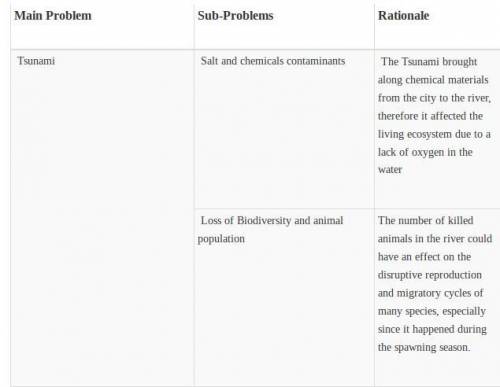
Biology, 13.11.2020 03:10 kdcloyd88191
Recovering Ecosystems Worksheet Section 1: Select the Kitakami River region, the Abukuma Highlands, or Japan's coastal habitat as the ecosystem you want to help with recovery. List the main problem faced by this ecosystem as described in the lesson. Then list at least two sub-problems that need to be considered to solve the main problem. List the sub-problems in order of most to least important. In the rationale column, explain why you placed your sub-problems in the order you selected. Main Problem Sub-Problems Rationale Section 2: Conduct internet research on your selected ecosystem to help you generate a list of three criteria and two constraints. Your criteria and constraints should consider relevant factors to the problem, such as costs, reliability, safety (to humans and wildlife), human needs, environmental impact, local biodiversity, and the aesthetics of the area. List the criteria in order of most to least important and assign each to a related sub-problem. In the rationale column, explain why you placed your criteria in the order you selected. Constraints Criteria Rationale Which Sub-Problems does this criteria address? Section 3: For at least one of the sub-problems, propose two solutions based on the information from the lesson and your additional research. In the rationale column, explain how your solution restores the stability and biodiversity of your selected ecosystem. Sub-Problem Proposed Solutions Rationale Section 4: Answer the following analysis questions about your proposed solutions. Describe the ways your proposed solutions decrease the negative effects of habitat destruction and human activity on your selected ecosystem. Describe the costs, safety, and reliability of your proposed solutions, as well as any social, cultural, and environmental impacts your solutions address. Evaluate your proposed solutions for their impact on overall environmental stability and changes. Which solution has more impact? Explain your reasoning for picking one solution over another. How could you refine one of your proposed solutions to further reduce environmental impact and loss of biodiversity while also addressing human needs?

Answers: 3
Another question on Biology

Biology, 21.06.2019 16:00
In this experiment you were asked to present three possible mechanisms. describe those mechanisms here and include drawings of those mechanisms. how will the bromination of trans-cinnamic acid and trans-stilbene allow you to distinguish between the three possibilities? what would you expect to find in your data in each scenario?
Answers: 1

Biology, 21.06.2019 21:30
What is the difference between bacterial infections and viral infections?
Answers: 1

Biology, 21.06.2019 23:30
Complete the sentences by matching the names of trees to the appropriate blanks. to do this, drag the names on the left into the appropriate blanks in the sentences on the right. match the words in the left column to the appropriate blanks in the sentences on the right. terms may be used more than once. make certain you have filled every blank with a term before clicking submit. 1. deciduous trees lose their leaves seasonally and include trees such as maple and elm. 2. conifer leaves are generally thin and needle-like, while seeds are contained in cones. conifers include cedar and pine. 3. evergreens are plants that maintain their leaves in all seasons and include trees such as cedar, elm, and pine. 4. hardwoods reproduce using flowers and have broad leaves; hardwoods include trees such as maple, , and cedar. elm returned you filled in 2 of 10 blanks incorrectly. mango trees are tropical broad leaf plants that maintain their leaves all year long. no credit lost. try again.
Answers: 2

Biology, 22.06.2019 02:30
Ecologist have observed a sharp increase of sulfur dioxide in the air . what might be a possible consequence of excessive sulfur dioxide in the air ? a. acid rain b. ozone layer depletion c.ozone layer hole d.increase in sea levels
Answers: 1
You know the right answer?
Recovering Ecosystems Worksheet Section 1: Select the Kitakami River region, the Abukuma Highlands,...
Questions

Mathematics, 29.01.2021 22:20

Biology, 29.01.2021 22:20

Mathematics, 29.01.2021 22:20



Mathematics, 29.01.2021 22:20

Computers and Technology, 29.01.2021 22:20

Mathematics, 29.01.2021 22:20




Mathematics, 29.01.2021 22:20

Mathematics, 29.01.2021 22:20

Mathematics, 29.01.2021 22:20

History, 29.01.2021 22:20


Physics, 29.01.2021 22:20

Mathematics, 29.01.2021 22:20


Mathematics, 29.01.2021 22:20




